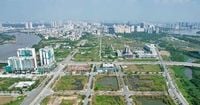Ho Chi Minh City, Vietnam’s bustling southern metropolis, is on the verge of a major transformation in how it governs and serves its more than 13 million residents. On August 13, 2025, the city’s People’s Committee (UBND TPHCM) formally proposed the construction of a centralized administrative center—a move aimed at streamlining public service, boosting efficiency, and matching the city’s rapid growth. This ambitious plan, as reported by multiple Vietnamese news outlets, comes in the wake of a recent administrative merger that elevated Ho Chi Minh City to the status of a “special urban area” with 168 commune-level administrative units.
Currently, the city’s administrative agencies are scattered across various locations, a legacy that’s become increasingly problematic. According to UBND TPHCM, this lack of synchronization creates “difficulties in coordination and operation,” hampering both day-to-day management and longer-term digital transformation efforts. The new center, if built, would provide workspace for an estimated 7,000 officials and civil servants, consolidating the city’s governance under one roof and promising better service for both residents and businesses.
The proposal isn’t just about bricks and mortar. City leaders see it as a strategic leap forward. As UBND TPHCM officials explained, the move is intended to “create a modern workspace, in line with the city’s current and future development needs.” They emphasized that a centralized hub would “enhance state management efficiency and better serve the public and enterprises.” With Ho Chi Minh City striving to become a leading economic and financial center in Southeast Asia, the stakes are high and the expectations even higher.
So where should this new administrative heart be built? After months of study and consultation, three potential sites have emerged, each with its own set of strengths and challenges. The first is the former headquarters of UBND TP Thủ Đức, combined with an adjacent 7.73-hectare plot of sports land in Thạnh Mỹ Lợi ward. This area already boasts existing infrastructure and is close to major transport arteries, making it a tempting choice for rapid deployment. The second option is an 11.6-hectare parcel of expanded Hà Tiên Cement land in Trường Thọ, Thủ Đức ward. Notably, this site is well connected to Metro line 1 and Võ Nguyên Giáp street, and it’s seen as an ideal location for a “smart administrative center” integrating public services, green spaces, and digital technologies. The third candidate is a cluster of land plots in the Thủ Thiêm urban area, adjacent to Tố Hữu street in An Khánh ward. At around 7 hectares, this centrally located site offers high symbolic value and sits at the heart of the city’s new urban vision.
Each location, however, comes with its own set of complications. The Thủ Đức headquarters and Thủ Thiêm plots are ready for immediate construction thanks to existing land and infrastructure, which could help the city “speed up project progress and minimize additional costs,” as noted in a recent Department of Construction report. But there’s a catch: the Thủ Đức site would require a thorough reorganization of agencies and staff, since the current number of civil servants isn’t enough to fully occupy the new facility. Without careful planning, there’s a risk of underutilizing valuable space, at least in the early stages.
The Hà Tiên Cement site, meanwhile, shines in terms of connectivity and its potential for a smart, integrated administrative hub. It’s “very suitable for developing a modern administrative center, integrating public services, green spaces, and digital technologies,” according to city planners. Yet the challenges here are formidable. The land is currently classified as industrial and would need significant remediation to address pollution, as well as the relocation of existing facilities and a change in zoning to public administrative use. All of this could slow down the timeline and increase costs, requiring tight coordination among city departments to avoid delays.
The Thủ Thiêm site, with its prime central location, is seen by some as a future icon for Ho Chi Minh City’s governance. However, it “has not yet fully aligned with current urban planning projects,” meaning that further adjustments and approvals would be needed before construction could begin. The site’s centrality offers great visibility and accessibility, but its planning constraints cannot be ignored.
As the city weighs its options, officials are keen to ensure that the final decision maximizes benefits for both the government and the public. The Department of Construction has been tasked with conducting a detailed evaluation of each site’s pros and cons, with the aim of presenting a comprehensive report to the city’s Party Committee. Once a site is selected and approved by the Party Committee’s Standing Board, the next steps will involve completing all necessary project documents, securing final authorization from the Standing Board of the City Party Committee, and launching the formal investment process.
City leaders are also focused on making the new center environmentally friendly and future-proof. The plan calls for “modern, integrated working spaces, public services, and green factors to create an efficient and environmentally friendly working environment.” This reflects a broader push to align Ho Chi Minh City’s development with international standards for sustainability and digital integration, a move that could set a model for other major Vietnamese cities in the years ahead.
For residents and businesses, the new administrative center promises more than just convenience. By centralizing services and improving coordination, the city hopes to “optimize administrative resources and provide significant convenience for citizens and businesses in accessing public services.” The initiative is also seen as a crucial step in supporting Ho Chi Minh City’s ambitions to become a regional economic powerhouse.
As the process unfolds, city officials have pledged transparency and adherence to legal procedures. The project will be carried out “in accordance with legal regulations, ensuring transparency, efficiency, and cost-effectiveness.” There’s a sense of urgency driving the initiative, as officials want to avoid the pitfalls of fragmented governance and keep pace with the city’s dynamic growth.
Urban planning experts are watching closely, with some predicting that Ho Chi Minh City’s new administrative center could become a benchmark for other large cities in Vietnam. By combining administrative efficiency with environmental sustainability, the city could set a new standard for urban governance in the country.
With a decision expected soon, Ho Chi Minh City stands at a crossroads. The choice of location will shape not only the city’s administrative landscape but also its identity as a modern, forward-looking metropolis. For now, residents and officials alike are waiting to see which site will be chosen—and how this bold plan will reshape the city’s future.




